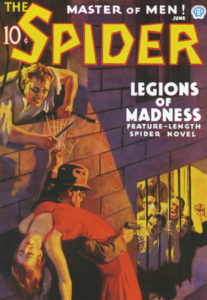
“Legions of Madness” was originally published in the June 1936 issue of The Spider Magazine. The city is in the grip of an insanity that racks its victims in endless homicidal rages. Nita van Sloan, beloved of Richard Wentworth, had tried to kill him, was hopelessly insane. Wentworth’s faithful servants had been tortured beyond human endurance. And the Master of Madness, chief of a powerful, fiendish syndicate, spreads his germs of mania unchecked.
This has all the makings of a great Spider story, and it’s early in the series’ run, which is always a good sign. But this story fails to deliver in the end, which leaves readers disappointed. It has all the earmarks of a story that was severely edited.
It’s as though the last two or three chapters were hacked off, and the new final chapter was slightly edited to wrap things up quickly. How quickly? In less than a page, things go from Wentworth in peril to the villain killed, Nita restored to sanity, and a lot of questions left unanswered. What makes this so tragic is that this was a great story right up until then. So because of the hacked ending, I can’t recommend this one.
Innocent men and women are going mad. In a homicidal rage, they kill wantonly. This comes on quickly and by the next morning has disappeared. The mad killers are back to normal with no memory of what they did. The plague of madness starts out small and gradually grows until at story’s end, hundreds are inflicted and thousands more imperiled. And who’s behind it all? Some hidden mastermind, of course. Someone who will be revealed at the end of the story, and will be a surprise to the readers. At least that’s the way it should have been. But since the story appears to be truncated; we are cheated out of that ending. What we get instead is a quick wrap-up… a cheat.
Wentworth is visited by Jules LeFevre, a Frenchman with a slight accent. Police know him as the man from Montmartre, one of the shrewdest criminals in France. LeFevre wants Wentworth to leave town; take the Normandie, to Paris. LeFevre plans on moving his operations to America and wants Wentworth out of the way. So when people start getting extortion letters demanding money, LeFevre is obviously starting up business in America.
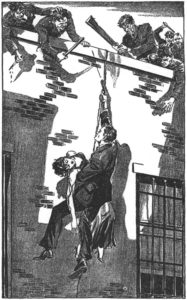
We also meet Margie Huron. She helps LeFevre escape from Wentworth’s penthouse after Wentworth takes him prisoner. She’s a reporter, an ex-actress, who is the girlfriend of Ricey Charlton. It seems that Ricey Charlton and Jules LeFevre are in the new extortion racket together, both lieutenants of some higher-up. Someone who will be revealed at the end of the story… or would have been if it hadn’t been cut. That’s just my opinion, of course.
Wentworth and Nita van Sloan go out for dinner and theater. When they return to Wentworth’s penthouse apartment, they find it in shambles. And Wentworth’s three aides — Ram Singh, Jenkyns, and Jackson — are hanging in the archway of the terrace doors. Hanging by their hands from nails that pierced their palms. They had been flogged. And that puts them in the hospital and out action for at least two weeks. So Wentworth has no assistants in this tale. Other than Nita and Police Commissioner Kirkpatrick.
The doctor who treats the three injured men indicates that the old butler Jenkyns is not expected to live. But nothing further is said about this. I’m assuming that if the last couple of chapters hadn’t been edited out, that loose end would have been tied up, and readers would have been assured he was on the mend. But obviously, he does… he’s in future stories.
I guess Wentworth gets a temporary butler. Later in the story a person called Jaffrey is mentioned. It’s not said that he’s the butler, but he does accept a phone call at Wentworth’s penthouse, so it’s a natural assumption. Jaffrey is never introduced or explained. The name is just mentioned a couple times.
Now about these extortion letters. Three men have been threatened, extorted to pay or have someone in their family driven insane. They will pay at a meeting of the board of directors of Insanity Inc. tomorrow in the Gaillard Building in the Board of Trade offices. One hundred thousand dollars cash. This purchases them a single share of Insanity Inc., which will protect them and their family from insanity. The deadline is 8 a.m. At 8:25 a.m., insanity will strike.
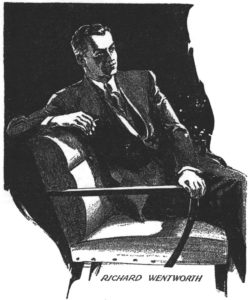
Strangely, the notes were signed with the fingerprint of Colonel Delancey Hanson, the police expert on fingerprints. How is it possible that he’s behind it all? He must be innocent. But by the middle of the story he goes mad and jumps out a window, so we never learn what that phantom fingerprint business was all about.
Well, our mastermind decides to punish the three men who reported their extortion to the police. Before the meeting, he drives them mad. Then collects from a bunch more men who have remained silent… and terrified. But of course, whoever this mastermind is, he’s not satisfied. So he just starts killing people off for the fun of it… or so it would seem.
And one of those people is Nita van Sloan. Actually, the poisoned cheese was meant for Wentworth. But Nita ate it, and went bonkers and tried to kill her boyfriend with a kitchen knife. Seems our bad guy gave that cheese an extra dose of the stuff, because Nita isn’t coming out of the insanity. In fact, if Doctor Higgens doesn’t find a cure for the mystery serum by noon, she’ll be permanently insane!
As you might guess, this drives Wentworth to see red. He will avenge her! And so he does, finally, in a wonderful saber duel on the roof of a 19-story building. That’s a pretty good scene, I’ll have to admit. Of course LeFevre cheats and wears chain mail beneath his clothes. So Wentworth’s saber bends and breaks near the hilt. But that doesn’t stop him. He battles on!
There are some strange inconsistencies in this story. One head-scratcher, for me at least, was when Doctor Higgens gives up all hope of finding a cure for Nita. Wentworth asks him if he has tried (and here he spouts some medical jargon). The doctor slaps his head; why didn’t he think of that! And naturally, it’s the cure. How convenient, especially for a non-medical man like Wentworth to think of it. And how implausible!
Doctor Higgens is another of those medical men who owe much to Wentworth. They seem to show up in every odd story or so, each time a different man, but always someone who doesn’t hesitate to obey Wentworth’s slightest wishes because of some unspecified debt owed to him. There sure are a lot of those doctors in the city, it seems.
At the beginning, LeFevre is portrayed as a gentleman thief. Then he switches to a brutal mass murderer. It does seem a bit strange, almost like author Novell Page changed his mind in the middle of writing the story.

Another puzzler for me was the Italian girl who helped Wentworth and battled alongside him and then suddenly went mad and started biting him. Why the delay? Everyone else is stricken immediately. Yet she doesn’t eat or drink anything for at least an hour during their frenzied escapades… then she goes mad. It’s never explained, and seems pretty inconsistent with the other plague victims.
As mentioned previously, this story has all the characteristics of a story that was originally longer, but was edited down by removing the final few chapters. Let me describe some of the reasons for coming to that conclusion.
First, the story ends way too fast. One moment Wentworth is in the hands of Ricey Charlton, doomed to be the next victim of madness. Then within one short page, a whole lot happens to resolve everything in a whirlwind. Margie Huron finally revolts and shoots Ricey Charlton, who, it turns out, was her brother, not her boyfriend. She confesses her love for Detective Jesse James. The phone rings; it’s Nita. She’s all right now; the doctor has found the cure. The end. Boy, talk about abrupt!
Note that The Spider doesn’t appear at the ending. It’s Richard Wentworth and Stanley Kirkpatrick who show up. And Wentworth doesn’t kill the bad guy; Magie Huron does. That’s just not how Spider stories end. In The Spider pulp novels, the story ends with The Spider’s appearance, and it’s The Spider who kills the mastermind.
I’m guessing there were a few more chapters in which the real mastermind is unmasked and battles The Spider in some fiendish death trap. It’s The Spider who finally polished off Mr. Big. He is probably revealed to be one of the millionaires previously introduced, a factory owner, since we are clued in earlier by LeFevre that his chief will have mad men destroy the factories of a rival town. And indeed the climax of the story takes place in Spencertown, where munitions factories produce explosives. That would have made a fantastic climactic scene: mad men loose among a hundred thousand tons of explosives.
Those closing chapters would have also explained away a lot of unanswered questions. Like, what of that business of the fingerprint of Colonel Delancey Hanson being on the extortion notes? That’s never explained, but I’m sure would have been if the story had been allowed to reach its natural conclusion.
Nothing further is said of Jenkyns the butler who lies on the brink of death after his brutal flogging in chapter one. I’m guessing this is one of the loose ends that would have been wrapped up in those missing chapters.
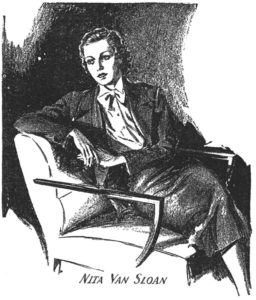
Nothing further is said about Insanity Inc. either. Seems strange to introduce this unique corporation, then abandon it so early. Maybe it was explained in the final chapters, as well.
Most Spider novels, especially those of this era, were in the 40,000 to 45,000 word range. Yet this particular story was only 36,000 words. That alone is reason to be suspicious. So, although I can’t prove it, I personally believe there was more to this story that ended up on the editor’s floor. I sure wish I could have read the un-purged version.
For all the frustration of dealing with an incomplete story, there were still some points of interest in it. For example, it was mentioned that The Spider has encountered criminal women before, but has never found it necessary to kill one. The Spider has killed so many people, I had not noticed that. I think that changed, as the series continued.
Another item of interest was the hidden room in Wentworth’s music room.
At his home, he sped to his vaulted music room and, before the pipe organ which filled the entire end, he tapped rhythmically on the orifices of three pipes. Faint ghosts of music sounded as the columns of air vibrated. He stopped abruptly, and strode rapidly along the paneled wall. One of the sections receded a few inches and slid noiselessly aside. He stepped through the secret doorway into a compact dressing-room whose walls held racks of clothing. There was a table whose mirror was ringed with brilliant neon lights and a rack of a hundred make-up materials with which Wentworth was brilliantly deft.
In many of these stories, Wentworth knocks out an opponent by flicking out his hand and compressing certain nerves in the throat which drop the man instantly unconscious. Not quite like the Doc Savage neck pinch, or its later incarnation used by Mr. Spock on Star Trek, but similar. It’s used at least three times in this story.
And we’re told that there is a standing reward of $50,000 of the head of The Spider. Apparently that’s not a new thing.
If, through some miracle, the chapters that I’m personally convinced were cut, actually do turn up and could be added back in to this story, I think it would make a darned good Spider story. But, unfortunately, as the story stands here, it feels incomplete and is very unsatisfying. And as such, it doesn’t get my recommendation.
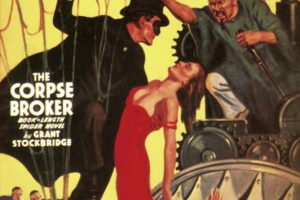


He was probably writing against the clock with little editing power and a deadline looming over his head.